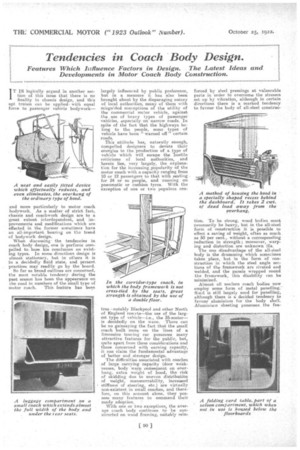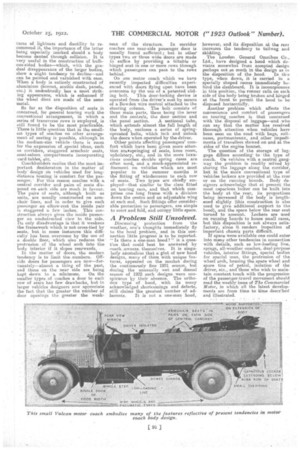Tendencies in Coach Body Design.
Page 20

Page 21

If you've noticed an error in this article please click here to report it so we can fix it.
Features Which Influence Factors in Design. The Latest Ideas and Developments in Motor Coach Body Construction.
IT IS logically argued in another section of this issue that there is no finality in chassis design, and this apt truism can be appliedwith equal force to passenger vehicle bodywork—
and more particularly to motor coach bodywork. As a matter of strict fact, chassis and coachwork design are to a great extent interdependent, and improvements and modifications which are effected in the former sometimes have an all-important bearing on the trend of bodywork design.
When discussing the tendencies in coach body design, one is perforce compelled to, base his conclusion on existing types. In some directions design is almost stationary, but in others it is in a decidedly fluid state, and present practices may readily go by the board.
So far as broad outlines are concerned, the most notable tendency during the past season has been the appearance on the road in numbers of the small type of motor coach. This feature has been largely influenced by public preference, hut in a measure it has also been brought about by the disparaging outcry of local authorities, many of them with misgu'ded conceptions of the utility of the commercial motor vehicle, against the use of heavy types of passenger vehicles, especially on narrow roads. In spite of the fact that the highways belong to the people, some types of vehicle have been warned off" certain roads.
This attitude has, naturally enough, Compelled designers to devote their energies to the production of a pipe a vehicle which will escape the 'hostile criticisms of local authorities, and herein lies, very largely, the explanation for the inereasing,popularity of the motor coach with a capacity ranging from 10 or 12 passengers to that with seating for 24 or so people, and running. on pneumatic or cushion tyres. With the exception of one or two populous cen tres--notably Blackpool and other North of England resorts—the use of the largest type of vehicle—i.e., the 35-seateris decidedly on the wane. There can be no gainsaying the fact that the small coach built more on the lines of a limousine touring car possesses many attractive features for the public, but, quite apart from these considerations and those concerned with earning capacity, it can claim the fundamental advantage of better and stronger design.
The difficultiea associated with, coaches of large carrying 'capacity (door weaknesses, body warp consequent on overhang, extra weight of hood, the risk of skidding due to uneven distributitm of weight, manoeuvrability, increased atiffness of steering, etc.) are virtually non-existent in small coaches, and therefore, on this account alone, they possess many features to commend their ready adoption,
With one or two exceptions, the average coach body continues to be constructed on wood framing, suitably rein
forced by steel pressings at vulnerable parts in order to overcome the stresses set up by vibration, although in certain directions there is a marked tendency to favour the body of all-steel construe
tion. To be strong, wood bodies must necessarily be heavy, but in the all-steel form of construction it is possible to effect a saving of weight, often as much as 50 per cent., without a corresponding reduction in strength; moreover, warping and distortion are unknown ills.
The one disadvantage of the all-steel body is the drumming which somelimee takes Place, but in the iorm of construction in which the steel angle sections of the framework are riveted and welded, and the panels wrapped round the framework, this disability can be minimized.
Almost all modern coach bodies now employ some form of metal panelling. SeA is still largely used for panelling, although there is a decided tendency to favour aluminium for the body shell. Aluminium sheeting possesses .the fea tures of lightness and ductility to recommend it, the importance of the latter being especially marked should a body become dented through collision. It is very useful in the construction of bulbous-sided bodies—which, with the gradual disappearance of the larger bodies, show a slight tendency to decline—and can be painted and varnished with ease. When a body is entirely constructed of aluminium (bonnet, scuttle dash, panels, etc.) it undoubtedly has a. most striking appearance, which is enhanced if the wheel discs are made of the same metal.
So far as the disposition of seats is concerned, for general touring work the conventional arrangement, in which a series of transverse rows is employed, is still found to be the most practicable. There is littlequestion that in the smallest types of coaches no other arrangement of seating is possible, although in the medium-size vehicle there is room for the expression of special ideas, such• as corridors, staggered armchair seats, semi-saloon compartments incorporating card-tables, etc. .
Coaehbuilders realize that the most important desideratum in the matter of body -design on vehicles used for longdistance -touring is comfort for the passenger. For this reasons coaches with a central corridor and pairs of seats disposed on each side are much in favour_ The pairs of seats, although built as units, are usually constructed on armchair lines, and in order to give each passenger an elbow-rest the inside pair is staggered a few inches. This construction always gives the inside passenger an unobstructed view to the side. Its only disadvantage is that it weakens the framework which is not cross-tied by seats, but in some instances this difficulty has been, overcome by the use of a double floor, which also reduces the protrusion of the wheel arch into the body interior if it slopes rearwards.
In the matter of doors, the modern tendency is to limit the-numbers. Offside doors for passengers are now—fortunately—almost a thing of the past, and those on the near side are being
kept .down to a minimum. On the smaller types of coaches a door to each row of seats has few drawbacks, but in larger vehicles designers now appreciate the fact that the greater the number of door openings the greater the weak
ness of the structure. In corridor coaches one near-side passenger door is usually found sufficient; but in other' types two or three wide doors are made to suffice by providing a tiltable or hinged seat in one or more rows through which passengers can 'pass to the rows behind.
On one motor coach which we have recently inspected difficulties experienced with doors flying open have been overcome by the use of a patented slid
ing bolt. This door-locking device is operated from the driver's seat by means of a. Bowden wire control attached to the steering column. The bolt consists of three main parts, these being the lever and the controls, the door section and the panel section. A sectional tube, which extends almost the full length of the body, encloses a series of springoperated bolts, which lock and unlock the doors when operated by the driver.
Other points affecting passengers' comfort which have been given more attention ansispringing of seats, knee room, upholstery, etc., and in the more luxurious coaches double spring cases are often used, and a much-appreciated refinement on vehicles which are most popular in the summer months is the fitting of windscreens to each row of *eats. Two types are chiefly employed--that similar to the class fitted on towing cars, and that which comprises one long frame with a division down the centre and an adjustable wing at each end. Such fittings offer considerable protection topassengers, are simple to erect and fold, and occupy little space.
A Problem Still Unsolved.
Discussing protection from the weather, one's thoughts immediately fly to the hood problem, and in this connection little progress is to be reported. " Is there a one-man hood?" is a lanesCon that could hest be answered by mach ,owners. themselves_ It is singularly slim/salons that a:glut of new hood designs, many of tham, with unique features, appeared on the market during the continuously fine 1921. season, but during the unusually wet and dismal season of 1922 such designs. were conspicuous hy their absence. The orthodox type of hood, with its many acknowledged shortcomings and defects, still claims the greatest number of ad
herents. It is not a orie,man hood, however, and its disposition at the rest increases the tendency to tailwag and skidding.
s
This I=London General Omnibus Co., LW., have designed a hood which deviates somewhat from accepted design perhaps not so much in the design as so
the disposition of the hood. In this type, when down, it is carried in a specially shaped recess immediately behind the dashboard. It is inconspicuous in this position, the runner rails on each side of the body being broken and hinged at the front to permit the hood to be disposed horizontally.
Another problem which affects the convenience and comfort of passengersan touring coaches is that concerned with the disposal of luggage—and who can say that the matter has received thorough attentions when vehicles have been aeon on the road with bags, suitcases, portmanteaux, and other impedimenta of travellers stowed on and at the sides of the engine bonnet.
The question of the storage of luggage differs according to the type of coach. On vehicles with a central gangway. the problem is readily -solYed by storing the luggage along the corridor, but in the more conventional type of vehicles lockers are provided at the rear or on the running boards. Body designers acknowledge that at present the most capacious locker can be built into the body at the rear, its proportions being increased if the body is lengthened slightly (this construction is also used to give additional support to the hood), and the space below the rear seat turned to account. Lockers are used on running 'boards to house small cases; but this disposition is not always satisfactory, since it renders inspection of important chassis parts difficult. If space were available one could enter into many other tendencies in connection with details, such as low-loading line, spra.gs, all-weather coaches, dual-purpose vehicles, interior fittings, spacial bodies for special uses, the protrusion of the wheel arch, housing the spare wheel and spare tins of petrol, isolation of the driver, etc., and those who wish to maintain constant touch with the progression of the passenger-travel movement should read the weekly issue of The Commercial Motor, in which all the latest developments are from time to time descried and illustrated_






















































